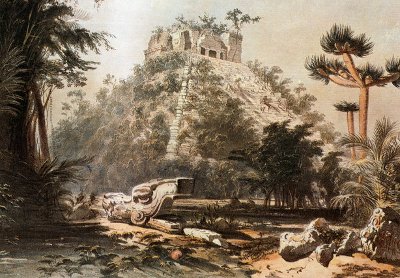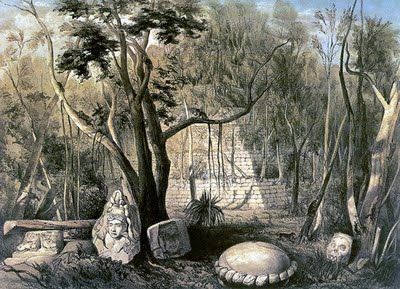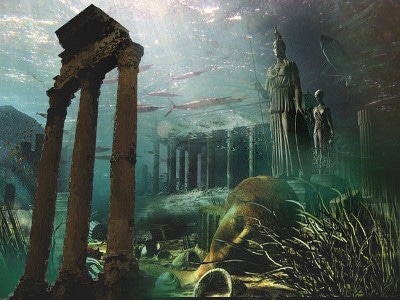
Once again we step into the realm of Man Knowledge, where we seek to broaden your understanding of various manly topics so that when the subject comes up in conversation, you’re ready to contribute. This time around, we’re off hacking through the jungles of who-knows-where and diving to the deepest depths of destinations unknown in search of that most mysterious of mysteries: Lost Cities.
As young boys, most of us were fascinated by tales of daring adventure, where men like Indiana Jones and Allan Quatermain dashed through perilous jungles with savage tribesman hot on their trail in search of some priceless artifact or other untold riches. A primary element in many of these stories continues to capture the imagination of both adventurers and academics alike even today…the lost city. While many lost cities have all but been written off as myth, others are still believed by many to be out there somewhere, their mysterious remains waiting to be unveiled once again to the world. What follows is a brief examination of several of the more prominent lost cities, providing you with some basic information and the principle theories surrounding each location.
El Dorado

Earliest Known Reference: c. 1530 in the writings of Spanish conquistadores
Theorized Location: Outside of present day Bogota, Colombia
Status: Dismissed as myth
El Dorado, which stands alongside Atlantis as the best known of lost cities, is now generally believed to not be a city at all. The name El Dorado, translated as “The Gilded One,” refers not to a mythical lost city, but to a long dead tribal leader from the Muisca people. This king, known to his own people as the Zipa, is believed to have been bound by sacred duty to offer sacrifices to a tribal deity that lived in Lake Guatavita (in present day Columbia). The king would do so by ritually covering himself with gold dust every morning and swimming out into the lake, as his people ceremonially threw gold and jewels out into the lake from the shore. By 1545 word of these practices had reached Spanish conquistadores, who moved to conquer the Muisca and claim their wealth as their own. As word spread, the story evolved, and the assumption was made that a golden king must live in a golden city. This, coupled with the conquistadores overhearing prisoners whisper about a mythical city in the area, became the origin of the lost city of El Dorado.
Several prominent expeditions were mounted in search of El Dorado, often with fatal consequences. Most notable among these were the misadventures of Sir Walter Raleigh, an English aristocrat who mounted two separate expeditions in search of the site. Raleigh claimed to have found a similar city in modern day Venezuela and documented the find in his book, The Discovery of Guiana. Returning again to the region to search for El Dorado years later, Raleigh found only trouble. After an armed encounter with Spanish soldiers in strict violation of his orders from English royalty, Raleigh was shipped home to England and swiftly beheaded. It is now believed that Raleigh’s writings on the subject of El Dorado and his findings related to the city were by and large exaggerated, which only fueled the growing mythical status of the lost city for centuries afterward.
Gaily bedight,
A gallant night
In sunshine and in shadow,
Had journeyed long,
Singing a song,
In search of El Dorado.
But he grew old —
This knight so bold —
And — o’er his heart a shadow
Fell as he found
No spot of ground
That looked like El Dorado.
And, as his strength
Failed him at length,
He met a pilgrim shadow —
“Shadow,” said he,
“Where can it be —
This land of El Dorado?”
“Over the Mountains
Of the Moon,
Down the Valley of the Shadow,
Ride, boldly ride,”
The shade replied —
“If you seek for El Dorado.”
-Edgar Allen Poe, El Dorado
Lost City of Z

Earliest Known Reference: Manuscript 512 (National Library of Rio De Janeiro) written by Portuguese explorer João da Silva Guimarães in the mid 18th century.
Theorized Location: Mato Grosso region of Brazilian Amazon
Status: Possibly found. Confirmation pending.
Originating with and made famous by legendary explorer/madman British Colonel Percy Fawcett, the Lost City of Z was believed to be the capital city of a great civilization which once thrived in the Mato Grosso region of the Brazilian Amazon. Fawcett, an iconic figure considered by many to be the last man of the era of solo exploration, disappeared into the wilds of the Amazon with his son in 1925, sparking what has since been labeled the greatest exploration mystery of the 20th century. Fawcett based his assumptions on the existence and whereabouts of the City of Z on snippets of information gathered through study of the writings of Portuguese explorers and by piecing together local legends and folklore.
Although Percy Fawcett is not quite the household name it once was, his life has certainly left a mark on history. As a personal friend to writers H. Rider Haggard and Arthur Conan Doyle, Fawcett’s real world adventures served as inspiration for the legendary characters these men created. His disappearance, along with the mystery of the Lost City of Z, has fascinated both academics and armchair adventurers for almost a century. While the mysterious fate of Fawcett may never be uncovered, it is believed by some that his fabled Lost City of Z has in fact been found. Remains of a very large, advanced civilization deep in the Mato Grasso, known as Kuhikugu, have just recently been discovered. Using advanced technology, scientists are still uncovering the vastness of this great city whose technology was equally as advanced as any elsewhere. Yet while it is certain that a great city has been found in the region, speculation continues as to whether it meets the description of the fabled kingdom that inspired Fawcett’s fateful expedition.
Atlantis

Earliest Known Reference: Plato’s dialogues Timaeus and Critias
Theorized Location: Most often the Mediterranean Sea, although proposed sites also include the eastern Atlantic Ocean, the Caribbean Sea, and the South Pacific.
Status: Lost
Atlantis reigns supreme as the best known of lost cities. First mentioned over 2000 years ago in Plato’s dialogues Timaeus and Critias, it was described as a large landmass somewhere west of the “Pillars of Hercules” (the points of land that nearly meet where the Mediterranean Sea separates the Spanish and North African peninsulas). Located somewhere in the Atlantic, the Atlantean civilization was believed to have been extremely prosperous, with a “confederation of kings, of great and marvelous power” (Plato, Timaeus) who maintained a powerful naval force in the region. According to Plato, the near-utopian society suffered a tragic fate, however, when a cataclysmic natural disaster led to the entire city being swallowed up by the ocean in a single day, leaving behind no trace of its existence.
“One grievous day and night befell them, when the whole body of your warriors was swallowed up by the earth, and the Island of Atlantis in like manner was swallowed up by the sea and vanished; wherefore also the ocean at that spot has now become impassable and unsearchable, being blocked up by the shoal mud which the island created as it settled down.”
-Plato, Timaeus
The 19th and 20th centuries saw a revival in interest in the Atlantean legend, and searches became more commonplace. Known for a strong interest in the occult and mysticism, the Nazi Party of Germany sponsored in-depth research on the lost city, believing that the fabled Atlanteans were possibly genetically connected to the Aryan race. More recently, as understanding of geological patterns and plate tectonics increased, it became increasingly clear that the scenario of an entire landmass disappearing overnight was highly improbable, and interest again waned. For many enthusiasts out there, however, there remain many unanswered questions regarding Atlantis, and the search continues.
Kitezh
Earliest Known Reference: Unknown. Originated in Russian folklore predating the 19th century
Theorized Location: Western Russia near the Volga River
Status: Dismissed as myth
Kitezh is a lesser known lost city that originates in Russian religious folklore. Generally dismissed by modern scholars as existing only in legend, it is considered to be the Russian version of the Atlantis myth. The legend speaks of a 12th century Grand Prince, Yuri II of Vladimir, who had a magnificent town built on an island off the shore of Svetloyar Lake in modern day western Russia. When Mongol invaders led by Batu Khan moved to conquer the town, they found it was completely exposed, lacking even the most rudimentary defensive structures. Even more unbelievably, the citizens of the town made no effort to defend themselves, but instead chose to simply kneel in prayer, invoking the Almighty to protect them. Unmoved by this display of piety, the Mongols prepared to strike. As they advanced, however, they were stopped short as massive geysers erupted across the town, shooting high into the sky. Astonished, the Mongols ceased their advance, watching as the geysers flooded the town and the island itself began to slowly sink into the lake, with its residents all the while praying for protection from on high.
As with any legend, the facts surrounding the possible existence of Kitezh and its extraordinary disappearance are few and far between. Oral tradition and folklore have colored the story for generations, and time has only made the legend more fantastic. It is now rumored that bells and singing can be heard from the shores of Svetloyar Lake on calm evenings, a guiding beacon which leads the pure in heart to the gates of Kitzeh, where its pious residents continue to walk the streets, shielded from the view of ordinary men.
Bonus: Lost City Found – Troy

Earliest Known Reference: Homer’s Iliad, 8th Century B.C.
Theorized Location: Northwest Turkey
Status: Found!
Troy, the magnificent city at the center of Homer’s epic Iliad, was long believed to have existed only in oral tradition and in the pages of Homer’s works and those that followed. It was not until Heinrich Schliemann began a chance archaeological excavation at a site in Northwest Turkey in the mid/late 19th century that it became clear that Homeric Troy was a very real place. Schliemann, a wealthy businessman and self-taught archaeologist, used prior studies done by the owner of the dig site to determine where to dig, and what he found would quickly become one of the greatest archaeological studies to date.
Troy is not one, but technically several different archaeological sites all existing in the same location and hidden at varying depths below the earth’s surface. One of these cities, known as Troy VII(a) is widely accepted to be the Troy of Homer’s Iliad. Now a World Heritage Site and considered to be one of the greatest discoveries of the modern world, Troy stands as testament that while most will continue to live on only in legend, lost cities do, every once and again, become found.
Sources and Further Reading
Finding the Lost Cities by Rebecca Stefoff
The Lost City of Z by David Grann
Exploration Fawcett by Percy Fawcett
Lost Cities of Atlantis, Ancient Europe & the Mediterranean by David Hatcher Childress


